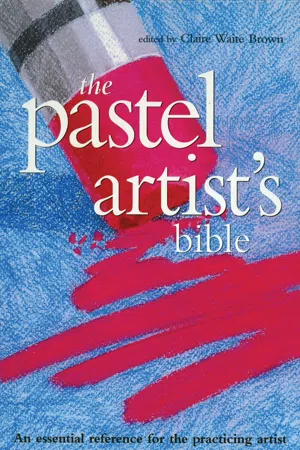Landscape Composing a landscape
There are few hard and fast rules for landscape composition, but there are some general pointers to bear in mind. A painting in which the eye is led into and around the subject is exciting and satisfying, because the viewer takes part in the picture. To create this sense of movement, curved or diagonal lines, in the form of a path or river running from foreground to middle distance, for example, are often used as a compositional device.
Linear elements can be used within the image to create space by indicating direction, such as lines of trees converging toward the horizon.
Establishing a relationship between various parts of a picture, whether of color, shape, technique, or tone, is also key to creating a successful composition. As you work, always think about the painting as a whole, and try to set up a series of visual links.
Finally, a painting needs an element of contrast, for example within shape, color, or tone. Rounded fluffy clouds could be the perfect foil for spiky trees, or use tiny touches of red or yellow, in the form of flowers or figures in the distance, to enliven large areas of green.
Lead-in lines
Subtle use of the conventional device of a road draws the viewer’s gaze toward the central group of houses, which forms the focal point of Cottages at St. Jacques, Brittany by Geoff Marsters. Color is also important to the composition: the eye is led by brilliant patches of acid green repeated from the foreground trees to the foliage in front of the houses.
Space through perspective
Perspective makes receding parallel lines appear to draw closer together until they finally meet. In landscapes such lines are unlikely to be perfectly straight, but they still converge in the distance, and observing this effect correctly will help you create the illusion of space. In Fen Landscape by Geoff Marsters, the lines emphasize the depth of the field and also depict the irregularities of the ground.
Linking colors
Sally Stride’s Oak in Winter uses a palette entirely composed of cool colors. Pale blues and mauves are typically cool, but here even the reds and yellows are selected to inject crisp, clear tints rather than dense, saturated colors. The warmest note is reserved for the strong red-brown woven into the linear structures of the foreground trees that create the focal point of the composition.
Contrasting shapes and tones
The river in Lois Gold’s Autumn Light draws the eye into the picture and divides the foreground into angular shapes, while the interplay of shapes is emphasized by avoiding detail. The curving shapes of woods and hills contrast with the angular shapes of the foreground, and the use of light, middle, and slightly darker tones keeps the landscape lively.
Leading the eye
The foreground should lead the viewer into the scene, and this can be done partly by pastel marks. The diagonal marks on the left and the curve on the right of Winter, Andalusia, by James Crittenden, lead us to the dark line of shadow and upward via the vertical straight edge of the tree. The eye then follows the line of trees and is led downward again with the vertical strokes of grasses, so that it travels right around the whole picture.
Diminishing size
In September Evening, Aubrey Phillips has made subtle use of perspective by bringing the curves of the waves closer together as they recede. However, it is the tiny figures at the far end of the beach that really suggest its depth and give a sense of distance; they are hardly more than dots and dashes in comparison with those in the middle ground.
Landscape Light and landscape
To paint realistic landscapes you must engage with the effects of natural light. The difference between a sunny and an overcast day is obvious, but the light also changes according to the time of day and the season. It can be difficult to fix such transient effects, but effective interpretation of light qualities comes from keen observation and confidence with your medium. Sometimes it helps to exaggerate contrasts of color and tones and be bold in your mark-making: when you step back the individual elements cohere into a striking image.
Cast shadows
In Eric Michael’s Journey to Zunil the shadows cast from the trees create the effect of pools and rivulets of light and shade floodin...







